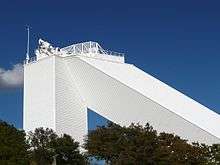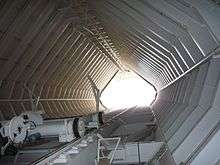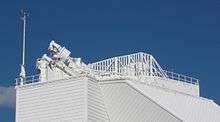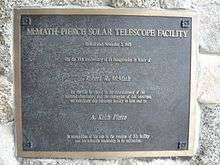McMath–Pierce solar telescope
 | |
| Alternative names |
McMath–Pierce Telescope |
|---|---|
| Named after |
Keith Pierce, Robert Raynolds McMath |
| Observatory |
Kitt Peak National Observatory |
| Location(s) | Arizona, US |
| Coordinates |
31°57′30″N 111°35′42″W / 31.9584°N 111.595°WCoordinates: 31°57′30″N 111°35′42″W / 31.9584°N 111.595°W |
| Organization |
National Solar Observatory |
| Altitude |
2,096 m (6,877 ft) |
| Observing time |
79 percentage |
| Telescope style |
Reflecting telescope Solar telescope |
| Number of telescopes |
3 |
| Diameter |
161 cm (5 ft 3 in) |
| Angular resolution |
0.07 arcsecond |
| Collecting area |
2.04 m2 (22.0 sq ft) |
| Focal length |
87 m (285 ft 5 in) |
| Mounting |
Equatorial mount |
| Website |
nsokp |
 Location of McMath–Pierce solar telescope | |
McMath–Pierce solar telescope is a 1.6 m f/54 reflecting solar telescope at Kitt Peak National Observatory in Arizona, United States. The building was designed by Myron Goldsmith and built in 1962. It is the largest solar telescope and the largest unobstructed aperture telescope in the world. It is named for astronomers Robert McMath and Keith Pierce.
Construction



The telescope is a triple instrument. In addition to the primary 1.61 m mirror fed by the 2.03 m heliostat, there are a pair of telescopes fed by 0.81 m heliostats mounted beside the main heliostat. These two instruments have 1.07 m and 0.91 m primary mirrors. [1]
The telescope uses the heliostat at the top of its main tower to direct the sun's light down a long shaft to the primary mirrors. The distinctive diagonal shaft continues underground, where the telescope's primary mirror is located. The theoretical resolution of the main telescope is 0.07 arcsec, although this is never reached because atmospheric distortions degrade the image quality severely. The image scale is 2.50 arcsec/mm at the image plane. Since 2002 the National Solar Observatory staff have developed an adaptive optics system designed for the unique needs of solar observatories that dramatically improve the resolution of science images.[2]
The secondary telescopes are called East and West. They are completely independent of the main telescope. These two auxiliary telescopes each have a 0.91-meter heliostat located beside the main heliostat. These auxiliary telescopes have a slightly shorter focal length and f-numbers of 50 and 44. The resolution of the auxiliary telescopes is 5.11 arcsec/mm and 5.75 arcsec/mm.[1]
The enclosure of the telescope was designed and engineered by the Chicago office of Skidmore, Owings and Merrill.[3]
At the dedication in 1962, Dr. Waterman read a letter[4] from President Kennedy starting with:
| “ | The great new solar telescope at the Kitt Peak National Observatory in Arizona is a source of pride to the nation. The largest instrument for solar research in the world, it presents American astronomers with a unique tool for investigating the nearest of the stars, our sun. This project is of exceptional interest to all our citizens... | ” |
Instruments

The third mirror of the main telescope which sends the light down into the observing room can be moved above three different positions. Two of these have a vacuum spectrograph beneath them, one of 18 meter deep and the other 4 meter deep with lower resolution but higher light throughput. These two spectrographs are able to rotate to compensate for the rotation of the image caused by the use of a heliostat. The third position can only be equipped with a static optical table with no image rotation correction and is therefore rarely used.

The auxiliary telescopes can only be used for imaging on static optical tables and do not provide image rotation correction.
Divestment by National Science Foundation and the Future of the McMath-Pierce solar telescope
The National Science Foundation announced that it was divesting from, and closing, the McMath-Pierce solar telescope as of the end of government fiscal year 2017. A non-profit organization, the Institute for Astrophysics Research and Experimentation, or IARE (also operating as Starstuff Technologies), submitted a proposal to the NSF on July 15, 2017 to continue operations and management of the telescope. The organization is raising funds through a GoFundMe campaign and private foundations to independently support the effort. The NSF should announce its decision whether to accept the Institute's proposal by November 2017 for a potential handover date of January 1, 2018.
See also
References
- 1 2 "McMath-Pierce Telescope and Instruments". National Solar Observatory. National Solar Observatory. Retrieved 28 March 2017.
- ↑ Keller, Christopher. "Low-Cost Solar Adaptive Optics". noao.edu. Archived from the original on 21 February 2016. Retrieved 14 May 2017.
- ↑ "McMath–Pierce Solar Telescope". Archived from the original on 2011-11-17. Retrieved 2012-03-16.
- ↑ "NSO/KP History of the MP Facility". Archived from the original on 2008-07-08. Retrieved 2008-05-16.
External links

- Kitt Peak virtual tour: McMath–Pierce Solar Telescope
- "McMath Solar Telescope of the Kitt Peak National Observatory", A. K. Pierce, Applied Optics, 3, 1337–1346, 1964.
- A History of the McMath–Pierce
- Schematic diagram of the McMath–Pierce telescope
- Adaptive optics at the McMath–Pierce telescope